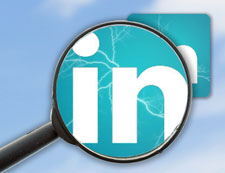
Someone asked me the other day why my email signature includes my LinkedIn profile. “You’re not looking for a job, are you?” she asked me. Her question illustrates why LinkedIn is under-appreciated: People spruce up their profiles when they are looking for jobs and do cursory searches when they have a job opening.
Few small businesses and nonprofits find LinkedIn effective, according to Ditch Digital Dabbling: How Small Businesses + Nonprofits Can Master Online Marketing and few report that their Human Resource Departments use any social media, including LinkedIn.
While there’s much more to LinkedIn than job search — discussion groups, questions and answers, becoming known as a thought-leader — let’s focus for now on finding the right people or the right placement.
Finding the a great employee doesn’t happen just when someone is actively looking for a job or a company has a vacancy to fill. People and companies are checking each other out all the time; something about you may strike a chord and a great relationship begins.
When your profile is up to date, it creates a full, searchable portrait of you, one that includes the normal resume stuff as well as what you care about, your portfolio demonstrating your work, skills not apparent in a job description, and recommendations. New sections allow you to list volunteer work and causes you support, both of which offer great information for nonprofits and insights about the person they might hire to small businesses. By including what you care about and devote your time to, you can stand out from other job candidates.
If an organization is looking for someone with particular interests and skills, it can reach beyond those who are actively looking for a job, to those who are the perfect hire but don’t know they want a change.
Big corporations have gotten the message and have become heavy users of LinkedIn for recruiting. But nonprofits and small businesses … not so much. Only 10% of small businesses use any social media, including LinkedIn, for recruiting. Nonprofits are a little more advanced; 29% of them use social media for recruiting but few are confident that their use of LinkedIn is effective.
It’s time for small businesses and nonprofits to dig deeper and learn more about this gold mine of professional connections and information.
For the organization, the search is far broader than a trade journal or newspaper ad and it is free to inexpensive, depending on the sophistication of the tools you use. For small businesses and nonprofits, those are big pluses.
Sterling Martin is an executive search firm specializing in finding senior managers for nonprofits. It uses LinkedIn to find candidates, both active – those listing themselves as looking for work – and passive – those who have the qualifications needed and an interest in the nonprofit’s field but are not looking for a new job. Those qualifications and interests are found by astute searches with carefully selected keywords. Reaching out to the latter often gets a positive response, says Virginia Record, client partner at Sterling Martin.
For nonprofits, that perfect hire, now employed at a corporation, may also turn out to be the right board member or volunteer. Again, LinkedIn’s database allows broad reach, low cost, and focus on most-needed skills. Recently, a new feature has been added to the paid LinkedIn Recruiter service. It allows better coordination of the hiring process as well as the ability to keep track of people who may be of interest down the road.
The National Association of Black Accountants is an 8,000-member association that needed a new board member who could help revamp the by-laws and revitalize the board. Board Chair Calvin Harris tried LinkedIn just for the heck of it. To his surprise, two names popped up, both connected to people whose recommendations he valued highly. One is now on the board.
No fuss. No muss.
As a small business or nonprofit, your LinkedIn profile is a rich source of information and connections for clients, donors, volunteers, and potential employees. They can get a feel for the personality of the organization as well as for the products and services it provides, especially if you encourage your staff and board members to keep their profiles up to date as well.
Be pro-active. Increase your LinkedIn visibility. No telling who will see it and what value they can add to your life.
The online marketing survey, Ditch Digital Dabbling: How Small Businesses + Nonprofits Can Master Online Marketing, gathered extensive data and benchmarks about how small businesses and nonprofits use online marketing and whether they are seeing results. The Executive Summary is available at no charge.
